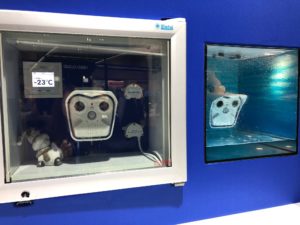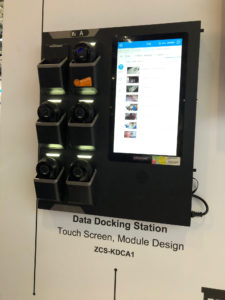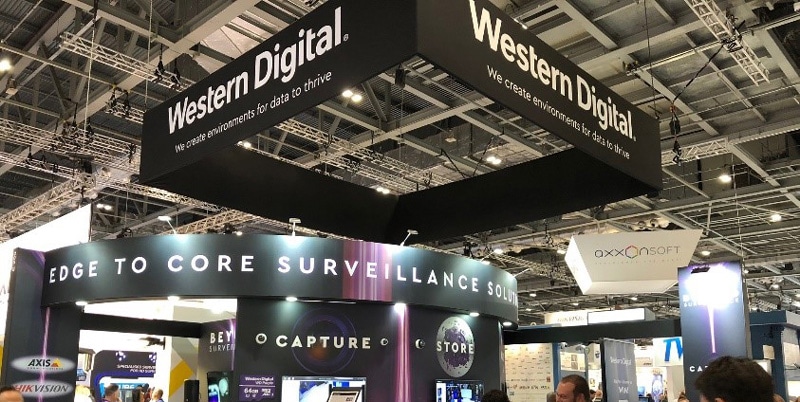Top 5 Surveillance Industry Trends from IFSEC International
A few weeks ago our team traveled to London to join the 600+ exhibitors and over 27,000 security professionals at IFSEC International. In addition to launching the industry’s highest capacity, deep-learning-capable, surveillance-class drive, Western Digital® Purple 12TB drive, I was able to walk the show floor. Here are the top 5 surveillance industry trends and takeaways for 2018.
#1 AI is everywhere!
Almost every exhibitor promoted their products with artificial intelligence (AI) in some way, shape or form. All manufacturers conveyed that they can help installers and integrators to have better ROI and customer satisfaction because of their advanced, intelligent solutions. Upon a closer look, however, you would find that not all AI is the same. The definitions are as diverse as the options for various use cases that were presented at the conference.
With advances in matrix math calculations and algorithms, AI has been increasingly developed and leveraged for surveillance because of machine learning (ML). Machine learning can be trained and adopted to recognize nuances and differences in patterns, shapes, colors, sounds, vibrations, temperature, chemicals and pressure, which are all important and at times critical to help identify and detect issues in real time. As a result, new applications such as facial recognition have been increasingly improved to conduct advanced identification, verification, search, prevention, response and rescue.
The opportunities for manufacturers and installers lie in the complex equipment and systems they provide and install. More importantly, they need to understand the role data plays in their entire operations- namely AI is made possible because of data. How data is captured, what data is captured, how exactly all the diverse data can be digested, interpreted, integrated and put into action is becoming one of the key differentiators for how one manufacturer/installer can stand out from the rest.
This is also where Big Data and Fast Data come into play (fast forward to Takeaway #5!).
#2 Deep Learning
It came as no surprise to see deep learning (DL) as one of the top surveillance industry trends at the show. AI continues to evolve to enable more complex machine and deep learning. Vendors at IFSEC made the effort to emphasize how their deep learning could enable activation and automation of processes based on their own unique solutions of matrix math calculation to deliver more meaningful results based on their analysis of activities and inference.
The concept of analyzing video to extract valuable insights is at the heart of deep learning. Effective deep learning in surveillance requires more robust computing power and many hours of “training” video, which is actual surveillance video footage from which objects and behavioral patterns can be analyzed. Deep learning ultimately leads to very competent AI, but can require thousands of hours of video footage to discern one human behavioral pattern. The opportunity to extract actionable insights from surveillance video is driving users to hold onto more footage, and hold onto it longer, stoking data storage growth even further. Deep learning continues to promise new ways to use surveillance video, to go beyond the traditional surveillance use case and to drive the industry to capture more, store more, and analyze more surveillance video.
Deep learning is happening at the surveillance edge, on surveillance video edge servers, whether on server-based VMS or AI-enabled NVRs, and on VSaaS cloud storage.
#3 “Mobile Surveillance”
Usually when we think of mobility it’s about smart phones and tablets, or portable devices like a laptop for the compute world. However, in the surveillance world, “mobile surveillance” means surveillance that’s happening in trucks, planes, trains, and automobiles…yes! mobile surveillance in transportation is a “thing” and one of the top surveillance industry trends at IFSEC! What’s important here are things like vibrations and temperatures for these moving parts. There are tons of vendors who cater to this market. There are an estimated 60 to 100 sensors for an average vehicle, and a projected revenue of USD 2.25 Billion for aircraft sensors market by 2022.
“Surveillance” is the overall term for sensors with specific purpose and functionality including pressure, temperature, force, torque, speed, position, level, proximity, flow, smoke, and more in devices such as accelerometers, gyroscopes, radar, altimeter, GPS, etc. They’re installed to monitor performance, survey different environments, monitor functionality and send event alerts if anything is irregular. Now, with all these sensors, you can’t help but wonder where does all the data go? How does any solution provider make sense of all the data not to mention the diverse nature of data captured from these sensors?

#4 Wearable Surveillance
This is no doubt THE year for wearable surveillance and one of the top surveillance industry trends. Vendors and attendees alike are looking for the most diverse but more importantly the most reliable solutions for police and security guards to protect public spaces including parks, stadiums, government offices, airports and transit stations, and public areas where people congregate such as churches and malls. Body cams are worn in different places such as on caps, over one’s ear, or across the chest with an audio headset attached for real time communication. Body cams are typically set to record live data at all times.
These wearable surveillance devices have security features of their own. In a typical application, body cams are returned and charged on a home base when they aren’t in use. Each device is assigned to an individual with a unique ID and passcode. All devices are connected to a central control center where AI is utilized to monitor activities from all devices at all times. Not only can the security guard or police officer radio the control center of any suspicious activity for help, but the control center can also detect any questionable or unusual movement to alert the security guard with a description of the perceived danger ahead.

Wearables are increasingly integrating more advanced technology to monitor all interactions. A stadium may have over 10,000 cameras running at once. There’s no way every location can be monitored by a single person or even a team. That’s where AI and machine learning come in! Data streamed back to the control center is analyzed for pattern recognition and behavior in great densities. If a suspicious foreign asset is detected that doesn’t belong, security will be notified immediately and given instructions to investigate. Imagine the time, resources and even lives that preventive surveillance solution can save!
Again, the question that’s convenient to be overlooked – how is AI or ML or advanced detection and warning possible? The clear and simple answer is data.
#5 Big Data & Fast Data, Cloud & Edge
When we talk about big data and fast data, where it’s located is important. Big data is aggregated in the cloud to collect large volumes of data and analyze it over time. It can also be the data captured on NVRs in between. However, fast data happens at the edge, on IoT devices where quicker analysis can be applied. We’ve seen in it autonomous cars, where decisions have to be made in real time. In surveillance, too, analytics need to happen at the edge where fast data can be quickly analyzed.
Increasingly, surveillance cameras are equipped with both embedded and removable storage. Sensors collect a lot of data, but they’re not intelligent on their own. The same goes for removable storage. New apps are most often loaded on embedded storage solutions, the heart and brain of fast data, where they can provide instant analysis. Imagine a stadium where surveillance cameras are monitoring streams of attendees filing in before a big game. If a fast movement (such as a bike, motorcycle or car) is detected and heading toward the entrance, fast data can analyze this without any human interaction. It can then send a distress signal to the command center for further analysis and dispatch help quickly!
Security is not all about capturing data because there are situations where we need instant analysis to react to an emergency situation, as discussed above. Those applications are built on systems where they reside on embedded storage solutions. Just like operating systems are updated on a smart phone that reaches out to other sites for applications, surveillance platforms continue to grow as well as the apps enabled by advances in the platform. For the surveillance market to continue to thrive, it takes an ecosystem. From platforms to manufacturers to app developers to OEMs and integrators, storage is needed at every step of the way.
Western Digital’s Portfolio for Surveillance from Edge to Cloud
Western Digital’s edge-to-cloud portfolio of surveillance optimized solutions allows you to capture, store, and analyze your surveillance data. With the introduction of our new 12TB WD Purple hard drive, we provide the capacity and performance to access and transform that data into valuable insights. To learn more about deep learning and AI in surveillance, check out our recent blog about the actionable insights surveillance data can provide with deep learning at the edge, on NVRs, or in the cloud.





